How does the General Electric plant work?
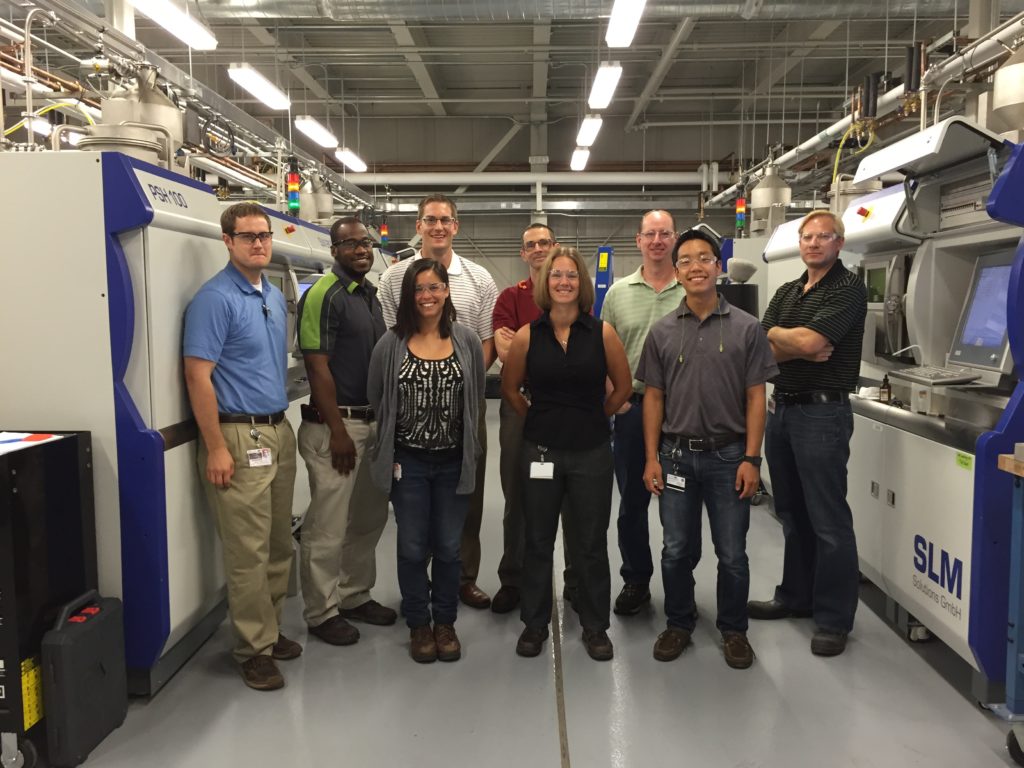
Industry 4.0 tools are used in a comprehensive manner by major global manufacturers today. Such “factories of the future” are a prototype of the model on the basis of which the production of the Fourth Industrial Revolution will be organized, and such enterprises become more and more. We will tell about the amazing prospects of the new industrial concept on the example of the “smart” plant of the General Electric company, where today are used:
- laser technology and robots;
- supermaterials;
- additive technologies;
- internet of things.
The industrial area on the outskirts of Greenville, South Carolina is not the most obvious place to go to look into the future. But there, behind railway tracks and box-shaped factories, you can find the new advanced plant of GE Power, which opened in April 2016. This place changes the very idea of how to create things.
')
Step into the future №1: laser technology and robotics
An enterprise occupying more than two football fields is like a huge tool box from the future, decorated with a giant GE monogram. The elegant MicroJet laser cutter directs the laser beam through a thin stream of water and cuts the shapes on the strongest metals, making it so accurate that they look like something unearthly. Industrial 3D printers and ovens with argon for the processing of spare parts made of lightweight and heat-resistant supermaterial - composites with a ceramic matrix (CMC) are installed at the plant in rows.
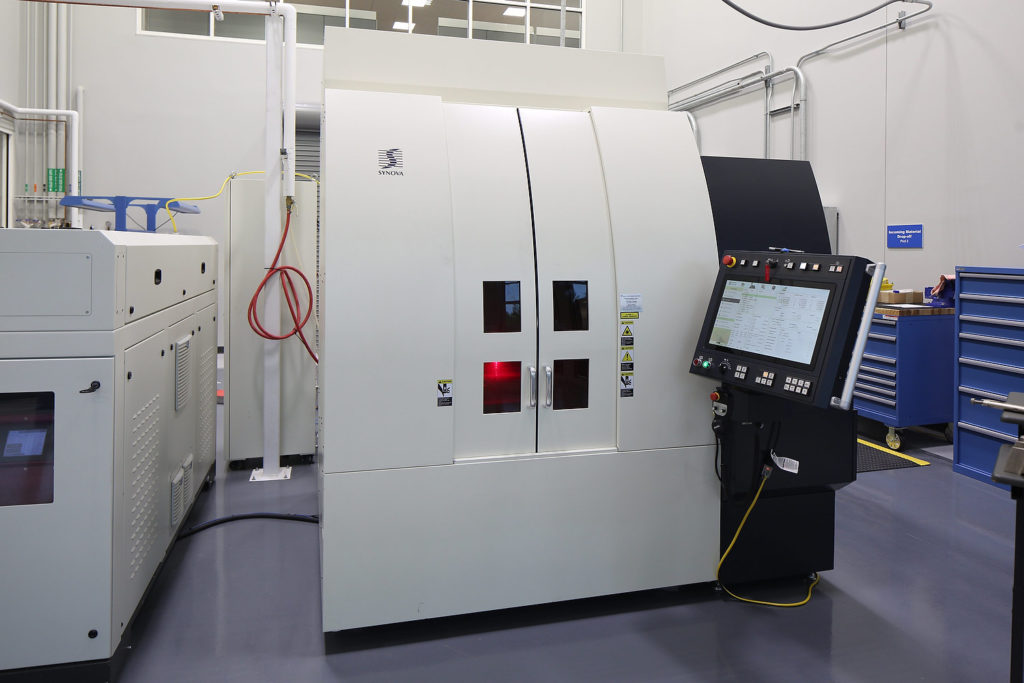
This laser device based on MicroJet technology uses a thin stream of water to focus the laser beam (a ruby glow inside the mechanism). It was originally developed for use in the diamond industry, but GE Power has adapted it to create the most accurate cooling holes in turbine blades and other details (see below). GE Power Photo
Somewhere off to the side — the robot, named Autonomous Prime in honor of Optimus Prime’s Transformers character, scans its work area with the eyes of the built-in LIDAR laser locator technology — the same technology used by Google to create self-driving cars — and serves a milling machine with a computer management. Most of the technologies presented here use built-in sensors that transmit data to the cloud for analysis and processing via secure industrial Internet channels.

General Electric engineer Vinson Blenton is standing next to Autonomous Prime. This robot is equipped with eyes with integrated laser locator LIDAR technology for moving heavy parts around the factory. The engineer says: “He studies space. He can actually see us. ” At the new plant, robots perform "dirty, complex, dangerous and boring tasks." GE Power Photo
Step into the future №2: super materials
During a visit to the plant by the GE Reports team, the machines made wavy compressor blades for the world's largest jet engine, ceramic gas turbine caps and other details of the most complex shapes and from the latest materials , the creation of which it was difficult to imagine a couple of years ago. According to Kurt Goodwin, the GE manager who runs the plant, “this enterprise is the bridge between the laboratory and reality. This is an incubator. We interact with engineers, allowing them to carry out their ambitious plans and helping them implement their results in mass production at a reasonable price. ”
Goodwin, a man who wears glasses, a gray beard and behaves like a friendly university professor, says: “Leonardo da Vinci brought the idea of a helicopter into the world, but it took 400 years for Igor Sikorsky to bring it to life. We have everything to help our inventors create here and now and without delay to introduce development into mass production . ”

The plant can produce parts of ceramic-matrix composites in furnaces and autoclaves, as in the photo above. GE Power Photo
GE Power has invested $ 75 million in plant construction. It is located next to a huge company in Greenville, where GE Power produces the world's largest gas turbines, weighing hundreds of tons, whose parts are made with an accuracy comparable to the thickness of a human hair. At the new plant, engineers and their colleagues from other GE divisions, such as GE Oil & Gas and GE Global Research, will test new models and structures, create prototypes in a short time, and then look for ways to mass-produce the best models. GE calls this project the sharing of knowledge and technology of the GE Store.
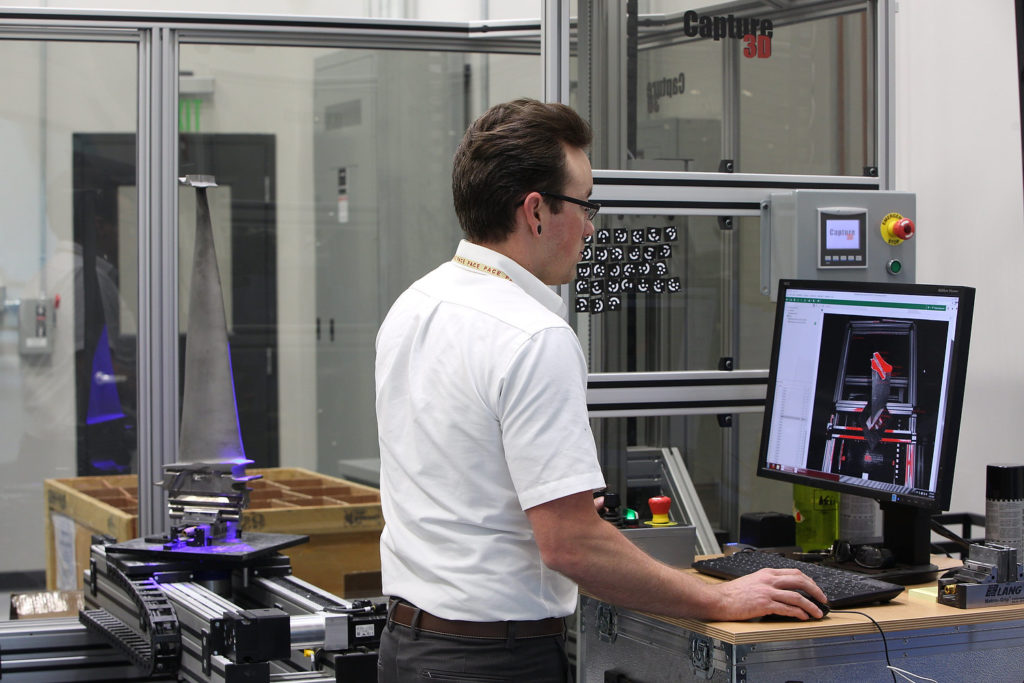
The 3D scanner with blue light technology allows engineers to monitor with maximum precision how complex parts, such as turbine blades, change with time after they are put into operation. GE Power Photo
Step into the future # 3: additive technologies
The second such enterprise is General Electric - the Center for Additive Technology Advancement in Pittsburgh, which helps the company to introduce additive manufacturing methods, among which 3D printing is the main issue.
According to Goodwin, a high-tech plant was needed by the company to keep pace with the needs of consumers. “It's incredible how quickly the world is changing,” he says. - Expectations of improvements offered by the market, are amazing. Our neighbor enterprise is the largest in the world, and it is already optimized for the production of gas turbines at the limit of its capacity. The workers of this plant have a lot of great ideas and there is no time for games. ”
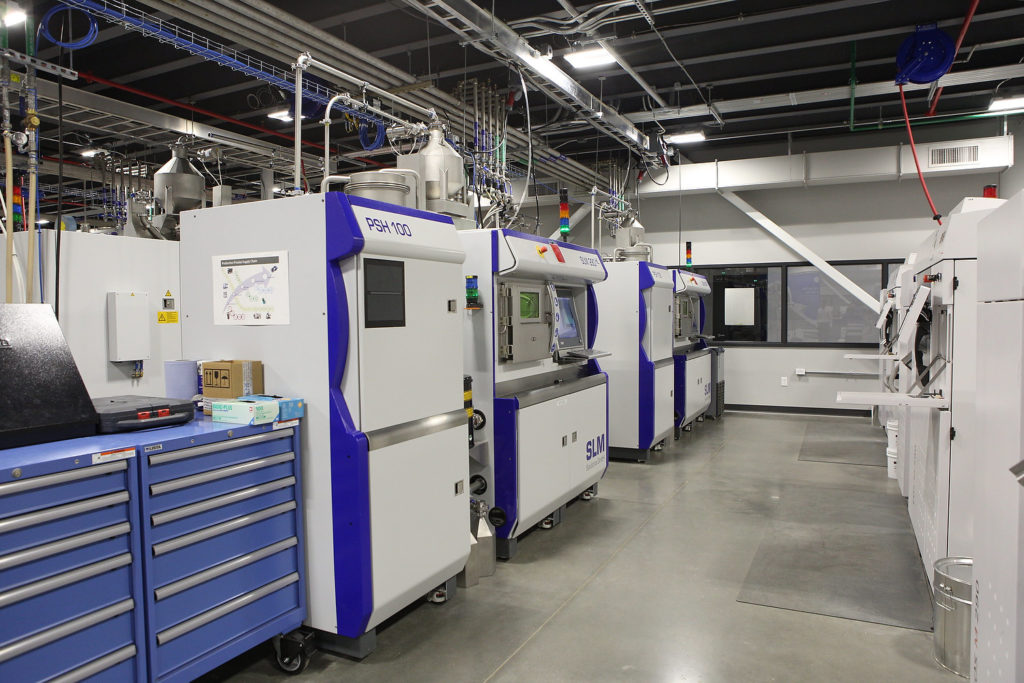
Engineers have given SLM Solutions additive installations nicknames such as Poison Ivy and Catwoman. Industrial 3D printing is still new, and each device behaves differently. These 3D printers will be involved in mass production. GE Power Photo
Here are installed the latest machines and devices for analyzing large amounts of data, but most importantly - it is the right people. The plant, where 80 employees will work, has already been hired by materials scientists with a doctoral degree, engineers and mechanics who have been honing their skills for decades. “We have carefully selected a team of inventive people who are focused on finding solutions and do not panic when something goes wrong,” says Goodwin. “They know what it means to fail quickly.” Together they can solve any problem. ”
The General Electric plant in Greenville manufactures parts for the world's largest jet engine, gas turbines and other products of the most complex forms and of the newest materials, the creation of which it was difficult to imagine a couple of years ago.
The work begins when the three-dimensional CAD-model of the first prototype arrives at workstations via the Internet. “We want the designers to show us their 'ugly brainchild' - a model that is only 80 percent complete,” says Blake Fulton, materials engineer, who works in the factory. “We understood that at this stage they are much more ready for feedback.” Then Fulton and his colleagues proceed to create a 3D model of the structure. It can be printed from plastic or metal , or even cut from wood.

Engineer additive production Chad Dulkevich printed on a 3D-printer samples for testing. GE Power Photo
Previously, designers sent their archives via express delivery service to contractors who made models and sent them back weeks later. Thanks to the direct transfer of data to 3D printers, designers in just a few days create many variants of drawings and immediately see how they will look in real life. “This is what we call rapid prototyping,” says Fulton.
In addition, Goodwin employees test all production processes. GE Aviation already uses parts printed on a 3D printer in jet engines, but when Goodwin had the idea to apply the same technology to gas turbines (they include many of the same parts as jet engines, but much larger), his way appeared obstacles.
GE Aviation has used direct metal laser melting installations based on 3D metal printing technology. It lies in the fact that the laser beam fuses layers of pure metal powder, creating parts from scratch. But the details of Goodwin were too large and were printed on DMLM machines for a very long time, which turned out to be economically inexpedient.

Gas and jet turbines operate under the influence of extremely high temperatures. Engineers have developed a sophisticated cooling hole system to maintain the most effective level of performance. MicroJet technology allows them to create new models, the production of which was previously impossible. GE Aviation photo
Goodwin instructed his team to find a more economical car. Due to the fact that 3D printing is still an innovation, the only faster device they could find was the SLM Solutions 3D printer with two laser beams, which had not even been released to the market yet. “We bought three,” says Goodwin.
It was a risky move, and soon difficulties began to arise. "We followed the instructions, but the product quality was unsatisfactory." The team spent four months analyzing 200 different software parameters and made 400 hardware modifications before the devices were debugged. Finally, they were used to optimize the design of a fuel injector printed on a 3D printer for the latest General Electric gas turbine and to put it into production. The new design reduces the level of emissions of nitrogen oxides, while increasing output power and performance. “We were able to complete 10 design options in just a few months, and then after four months send the final version to production,” says Goodwin. “It usually takes a year.”
Step into the future №4: Internet of Things
GE uses the Predix software platform to stream data through the industrial Internet to the cloud, analyze and transmit problems and solutions to the team.
Such feedback loops are part of the GE concept called “digital thread”. Clay Johnson, director of information technology for GE Power, says the plant still demonstrates only a fraction of what is expected in the future. According to him, the “digital stream” will constantly move data from customers and suppliers to GE and back.
“The system will receive real-time feedback through sensors located on the details inside the devices,” Johnson notes. - In the future, the part will itself “understand” that it is becoming unusable, automatically ordering the reconfiguration and assigning a serviceman who will install the update. This is a real Uber for the industry. ”
But technology will not solve all problems. Steve Bolze, CEO of GE Power, said after the opening ceremony: “We have robotics and 3D printers, but the main thing is our people who trust each other enough to take risks and create the future together.”
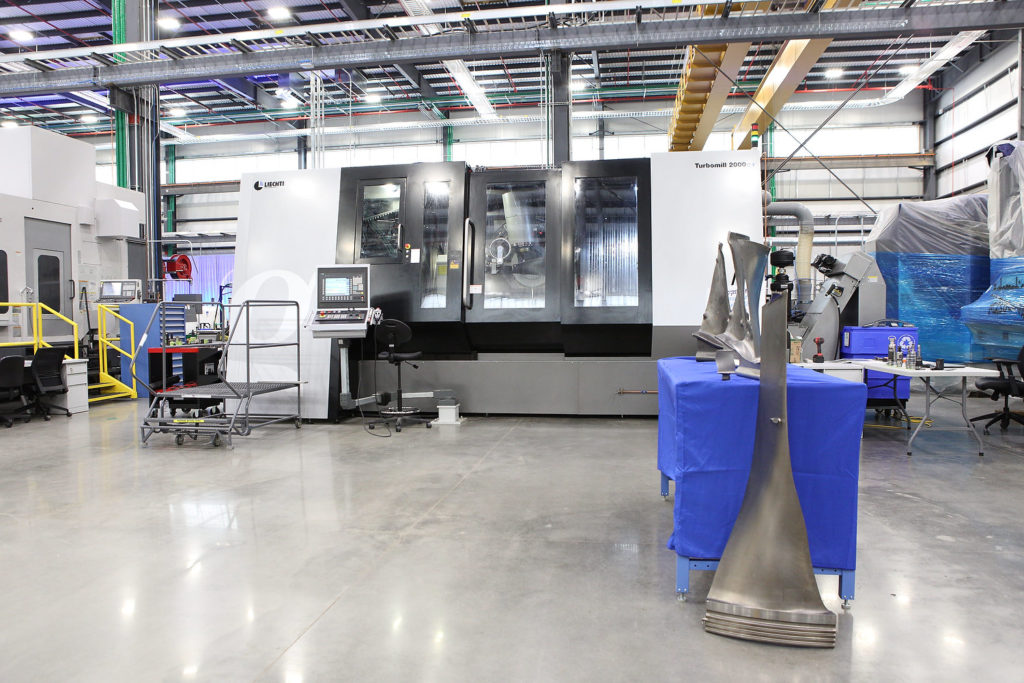
This massive machine makes compressor blades for the world's largest jet engine GE9X. GE Power Photo
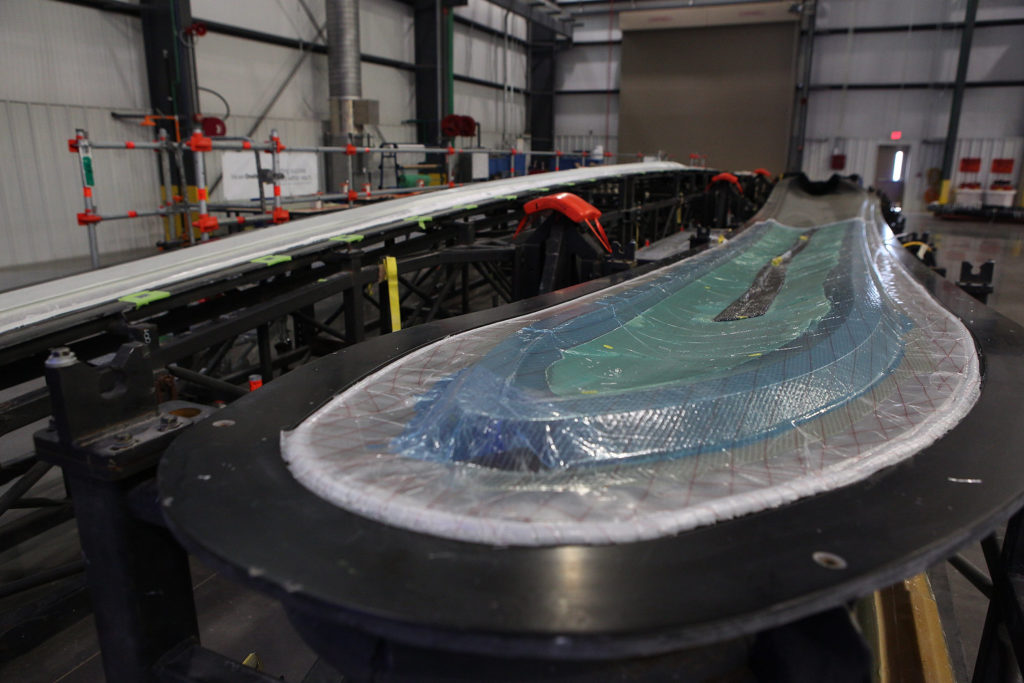
GE Power scientists use these two models of wind turbine blades to develop more robust and accurate parts from modern polymers. Manufactured blades can be tested here on the test machine. GE Power Photo
Author: Thomas Kellner, ge.com. Translation from English.
Source: https://habr.com/ru/post/441646/
All Articles